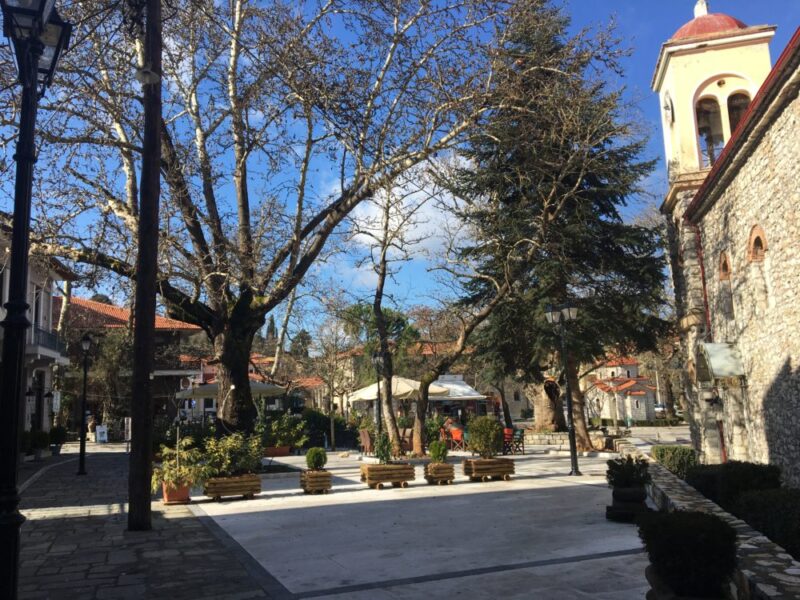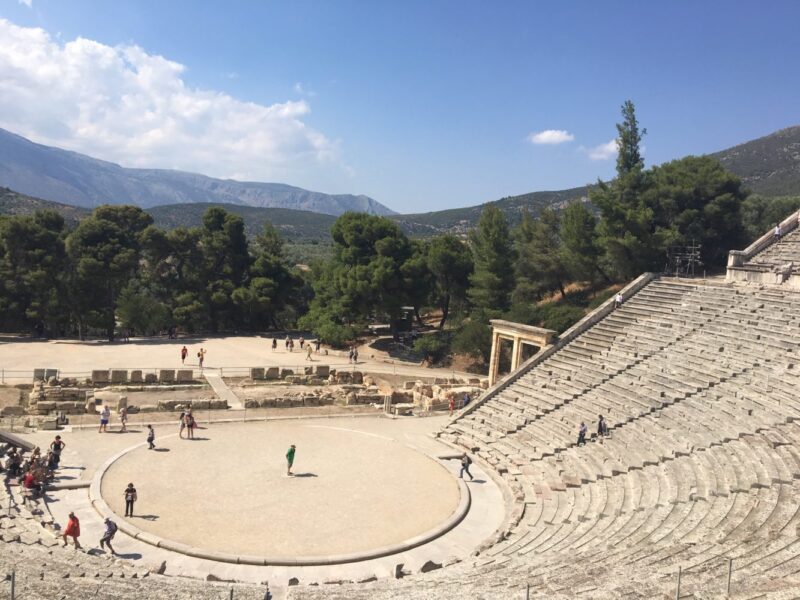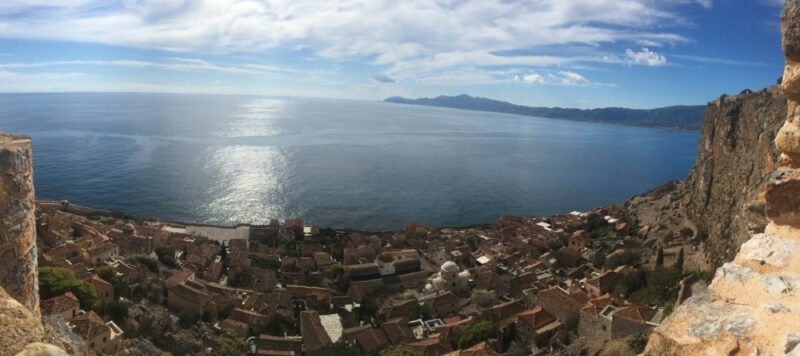We propose you to go to Pylos and dive into the heart of Messinia . This unknown region is located in the westernmost finger of the Peloponnese, in the vicinity of Kalamata.
And yet Messinia is full of treasures. Mountainous reliefs, a green and generous nature with its “seas” of olive trees and pine forests, protected bays with clear waters and fine sand, breathtaking viewpoints… But also the vestiges of an eventful history, trace of the covetousness of which this region was the object, for centuries.
The bay of Pylos

We started our journey in the bay of Pylos (formerly named bay of Navarino). This bay, almost closed by the island of Sfactiria, stretches its large cliffs falling abruptly into the sea. It was the scene of a great naval battle in 1827. The three powers in favor of the independence of Greece (France, Russia and Great Britain) sent ships in the bay where the Ottoman fleet anchored (supported by the Egyptians) to “impress” them and to make impose the armistice with the revolted Greece. A memorable battle ensued in which the Ottomans, despite their numerical superiority, lost most of their fleet.
Fortunately, today the few sailboats that sail in the bay, animate in a peaceful way this charming panorama. We advise you to stop in the north, on the charming waterfront of Gialova . Indeed, there are some nice stores, and of course cafes and restaurants! But in a micro format. We are talking about a street of only 300 m long!
We suggest that you relax in the shade of the mulberry trees in the Natura restaurant or on the beach, which is equipped with deckchairs and poufs. Property of the establishment Zoe Resort It is adjacent to a hotel area where the rooms have a direct view of the sea. Prefer the renovated part with its rather spacious family rooms.
Walk on the beach
From there, you can take a beautiful 3 km walk along the beach to Divari (Golden Sand/Beach*). You go along the Gialova lagoon, a bird sanctuary with 250 different species (to be done in the early morning to enjoy the birds). Push a little further (1 km more) to the promontory of Koryphos where the “old” castle (Paleokastro) culminates as opposed to the “new” (Niokastro). The latter is located opposite the harbor, in Pylos, on the road to Methina. The first was built by the Franks during the 4th crusade in the 13th century, while the second was built by the Ottomans in the 16th century.
*The Golden Sand beach (2 beach cafes open in high season) is also accessible by car, taking the road to Gianouleika and following the Golden beach signs.
The beach of Voidokilia
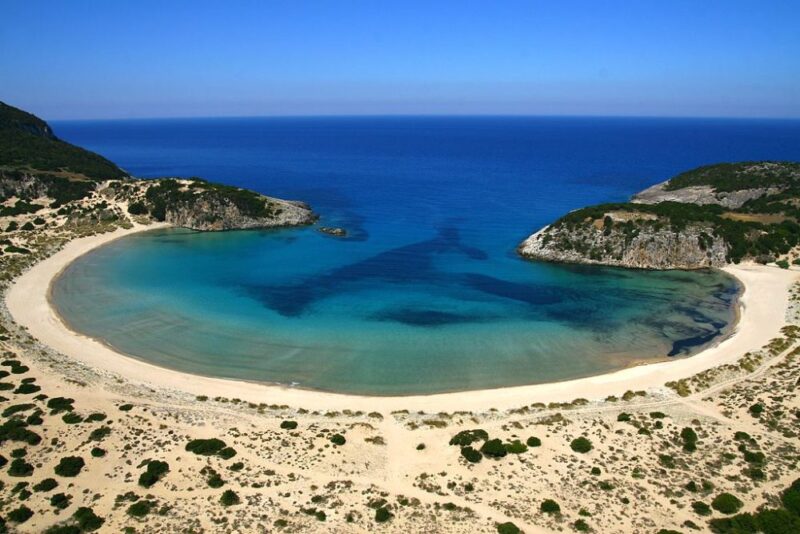
Still in the northern part: a jewel not to be missed, the beach of Voïdokilia!
You can get there by driving around the lagoon.
You’ve probably already viewed photos from the sky of this horseshoe or omega-shaped beach Ω (this is Greece, after all, let’s use local references!). Idyllic for those who are not looking for sunbeds or beach cafes but just white sand, turquoise waters and a gentle slope to splash around! It can be windy at times, but the northern part, under the cliff, is sheltered and ideal for children. You can discover its unbelievable shape and a magnificent panorama by climbing the promontory of Paleokastro, up to the cave of Nestor. The visit of the “old” castle is now forbidden for security reasons.
Nestor’s Palace
Even further north, if you wish to discover the Mycenaean civilization, visit the Palace of Nestor, located in the town of Chora/Hora. It was built in the 14th BC, for the Achaean ruler Nestor. The latter was famous for having taken part in the expeditions of the Argonauts and in the Trojan War. The excavations conducted by the Americans, have uncovered, in addition to the ruins of 3 buildings (now housed in a shed), more than 600 tablets of Linear B (the archaic form of ancient Greek) as well as frescoes, exposed in the museum of Chora / Hora.
But by the way, Pylos?
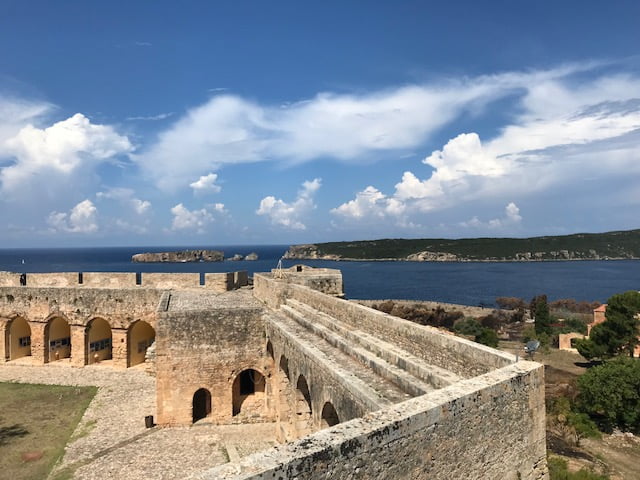
This small town of less than 2000 inhabitants was founded by the French expeditionary corps of Morée. Morée is in fact the name given to theFrench land intervention in the Peloponnese after 1827.
The charm of a small provincial town
The city spreads out around a shaded central square, the Place des Amiraux, and on the heights of the promontory. You can take the time to stroll through its stairs, its alleys and its port to taste its old-fashioned charm.
A must: the visit of the citadel
The Neokastro was built by the Ottomans, then occupied by the Venetians and later restored by the French. In the center of the city, there is an old mosque converted into a church by the Venetians, as well as a hexagonal fort and a museum. The walk on the crenellated ramparts offers magnificent panoramas on the bay.
A small quiet port
But you can also choose to sip a fredo (or any other Greek beverage) on the port or on the terrace of thehotel restaurant Karalis Beach, ideally located under the citadel and overlooking the sea. Ah the memory of their (copious) breakfast, in the calm, under the awning, swept by the sea breeze and punctuated by the passage of sailboats!
As you leave Pylos to go to Methoni, you will notice the Aqueduct, built by the Turks to feed the citadel (the new one if you have followed everything!).
Methoni (Modon)

Another medieval stronghold established in a place as strategic as it is divine!
This fortress, which housed homes and businesses, was built by the Venetians in the 13th century on their return from the Crusades. But as early as 1500, it was conquered by the Turks. Then it was taken over by the Venetians in 1680. Finally … re conquered by the Turks in 1715! It will eventually decline, as the naval trade runs out of steam (you bet!).
The traces of the past remain: a large wall, bastions, a granite column, Turkish baths, a church and, at the southern end, an octagonal Turkish tower that seems to spring from the waves … without forgetting the entrance bridge, work of the passage of the French. All this in a harbor with turquoise waters facing the island of Sapientza. Amazing!
So, to enjoy this splendor, we advise you to have a drink at Methoni beach hotel . You’ll have earned it after walking all those miles!
For even more things to do and see in Messinia, check out our article with our 10 Must-See in Messinia.
Practical information
How to get to Messinia?
- By car: from Athens at 3H30 (by the recent highways A8 and A7)
- By bus: direct from Athens (1 bus / day) or via Kalamata (3 to 4 buses / day). Information KTEL Messinias (Tel: +30 2721 028 581)
- By plane: local flights (from Athens, Thessaloniki…) or international (Paris) to Kalamata. Our advice, use the Aegean company.
Where to stay: finding accommodation?
- To the three turtles – methonie: An eco-hotel in an organic olive grove, economical and fantastic
- Zoe Resort – Gialova: extraordinary view of the sea
- Hotel Karalis beach – Pylos
- The Westin Resort – Costa Navarino: a luxury resort in an exceptional setting
Karine E.


